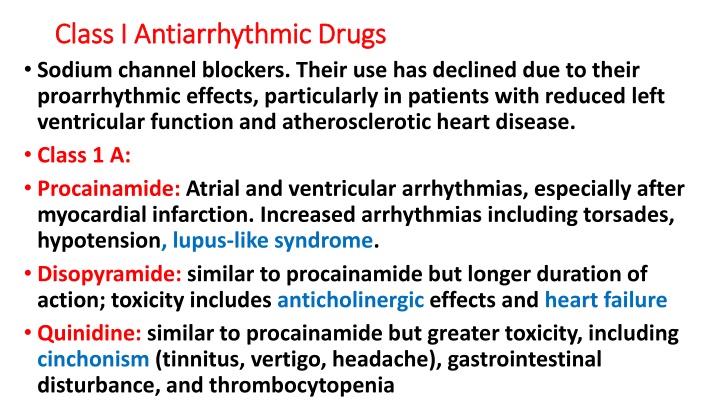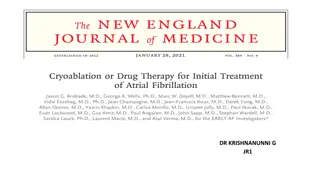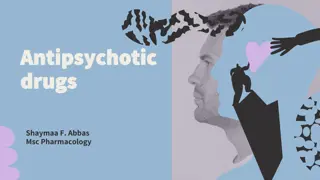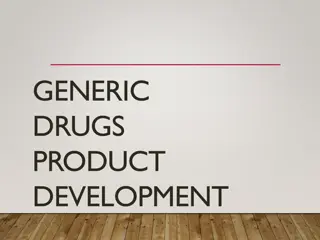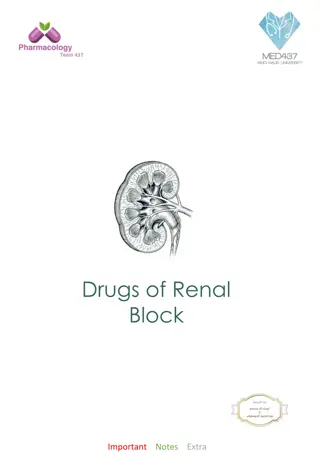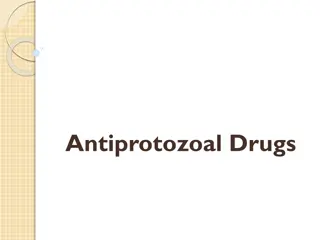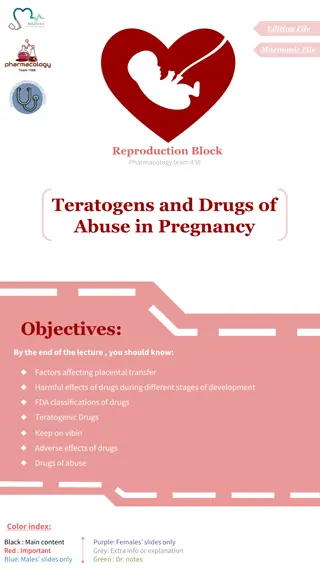Overview of Antiarrhythmic Drugs Use and Classification
Antiarrhythmic drugs are classified into different classes based on their mechanisms of action. Class I includes sodium channel blockers with specific drugs like procainamide, disopyramide, and quinidine. Class 1B involves lidocaine and mexiletine. Class 1C consists of agents like flecainide. Class 2 blockers diminish phase 4 depolarization, while Class 3 K+ channel blockers, like amiodarone, prolong the action potential. Each class has specific indications and potential side effects.
Download Presentation

Please find below an Image/Link to download the presentation.
The content on the website is provided AS IS for your information and personal use only. It may not be sold, licensed, or shared on other websites without obtaining consent from the author.If you encounter any issues during the download, it is possible that the publisher has removed the file from their server.
You are allowed to download the files provided on this website for personal or commercial use, subject to the condition that they are used lawfully. All files are the property of their respective owners.
The content on the website is provided AS IS for your information and personal use only. It may not be sold, licensed, or shared on other websites without obtaining consent from the author.
E N D
Presentation Transcript
Class I Antiarrhythmic Drugs Class I Antiarrhythmic Drugs Sodium channel blockers. Their use has declined due to their proarrhythmic effects, particularly in patients with reduced left ventricular function and atherosclerotic heart disease. Class 1 A: Procainamide: Atrial and ventricular arrhythmias, especially after myocardial infarction. Increased arrhythmias including torsades, hypotension, lupus-like syndrome. Disopyramide: similar to procainamide but longer duration of action; toxicity includes anticholinergic effects and heart failure Quinidine: similar to procainamide but greater toxicity, including cinchonism (tinnitus, vertigo, headache), gastrointestinal disturbance, and thrombocytopenia
Class 1B: Class 1B: Lidocaine: Although amiodarone is the drug of choice for ventricular fibrillation or ventricular tachycardia (VT), lidocaine may be used as an alternative. IV and IM. CNS sedation or excitation Mexiletine: Mexiletine is used for chronic treatment of ventricular arrhythmias, often in combination with amiodarone. Dyspepsea
Class 1C: Class 1C: Due to their negative inotropic and proarrhythmic effects, use of these agents is avoided in patients with structural heart disease (left ventricular hypertrophy, heart failure, atherosclerotic heart disease). Flecainide: useful in the maintenance of sinus rhythm (rhythm control) in atrial flutter or fibrillation in patients without structural heart disease and in treating refractory ventricular arrhythmias.
Class 2: Blockers Class 2: Blockers Diminish phase 4 depolarization and, thus, depress automaticity, prolong AV conduction, and decrease heart rate and contractility. Useful in treating tachyarrhythmias caused by increased sympathetic activity. They are also used for atrial flutter and fibrillation and for AV nodal reentrant tachycardia (SVT). - blockers prevent life-threatening ventricular arrhythmias following myocardial infarction. Common SE: bradycardia, hypotension, and fatigue Metoprolol: is the most widely used -blocker for the treatment of cardiac arrhythmias. Compared to nonselective -blockers, such as propranolol, it reduces the risk of bronchospasm. Esmolol: selective 1-receptor blockade; IV only, 10-min duration. Used in perioperative and thyrotoxicosis arrhythmias
Class 3: K+ channel blockers Class 3: K+ channel blockers These agents prolong the duration of the action potential & prolong the effective refractory period. All class 3 drugs have the potential to induce arrhythmias (prolong QT interval) Amiodarone: Contains iodine and is related structurally to thyroxine. It has complex effects, showing class 1, 2, 3, and 4 actions, as well as -blocking activity. Its dominant effect is prolongation of the action potential duration and the refractory period by blocking K+ channels.
Amiodarone is effective in the treatment of severe refractory supraventricular and ventricular tachyarrhythmias. It is the mainstay for rhythm management of atrial fibrillation or flutter. Amiodarone is unusual in having a prolonged half-life of several weeks. Full clinical effects may not be achieved until months after initiation of treatment, unless loading doses are employed Pulmonary fibrosis, neuropathy, hepatotoxicity, corneal deposits, optic neuritis, blue-gray skin discoloration, and hypo- or hyperthyroidism. Despite its adverse effect profile, amiodarone is thought to be the least proarrhythmic of the class 1 & 3 antiarrhythmic drugs.
Sotalol: Class 3 antiarrhythmic agent & nonselective - blocker. Used for maintenance of sinus rhythm in patients with atrial fibrillation, atrial flutter, or refractory paroxysmal SVT and in the treatment of ventricular arrhythmias. Since sotalol has -blocking properties, it is commonly used for these indications in patients with left ventricular hypertrophy or atherosclerotic heart disease.
Class 4: Ca channel blocker Class 4: Ca channel blocker Nondihydropyridine Ca2+ channel blockers verapamil and diltiazem slow conduction in AV node and pacemaker activity. These agents are more effective against atrial than against ventricular arrhythmias. They are useful in treating reentrant supraventricular tachycardia and in reducing the ventricular rate in atrial flutter and fibrillation. Cardiac depression, constipation, hypotension Verapamil: AV nodal arrhythmias (SVT), especially in prophylaxis Diltiazem: Rate control in atrial fibrillation.
Miscellaneous Miscellaneous Adenosine: The drug decreases conduction velocity, prolongs the refractory period, and decreases automaticity in the AV node. Intravenous adenosine is the drug of choice for converting acute supraventricular tachycardias. Duration: 10 15 s. Flushing, bronchospasm, chest pain. Magnesium ion: Possible increase in Na+ /K+ ATPase activity. It is the drug of choice for potentially fatal arrhythmia torsades de pointes and digoxin-induced arrhythmias
Digoxin Digoxin Digoxin inhibits the Na+/K+-ATPase pump, ultimately shortening the refractory period in atrial and ventricular myocardial cells while prolonging the effective refractory period and diminishing conduction velocity in the AV node. Digoxin is used to control ventricular response rate in atrial fibrillation and flutter (rate control). At toxic concentrations, digoxin causes ectopic ventricular beats that may result in VT and fibrillation. Serum concentrations of 1.0 to 2.0 ng/mL are desirable for atrial fibrillation or flutter
MCQ MCQ A 60-year-old woman had a myocardial infarction. Which agent should be used to prevent life-threatening arrhythmias that can occur post myocardial infarction in this patient? A. Digoxin B. Flecainide C. Metoprolol D. Procainamide Flecainide should be avoided in patients with structural heart disease.
MCQ MCQ A 78-year-old woman has been newly diagnosed with atrial fibrillation. She is not currently having symptoms of palpitations or fatigue. Which is appropriate to initiate for rate control as an outpatient? A. Amiodarone B. Esmolol C. Flecainide D. Metoprolol D is an option to control rate. Esmolol is IV only. The others are used for rhythm control in patients with atrial fibrillation.
MCQ MCQ Which arrhythmia can be treated with lidocaine? A. Paroxysmal supraventricular ventricular tachycardia B. Atrial fibrillation C. Atrial flutter D. Ventricular tachycardia Lidocaine has little effect on atrial or AV nodal tissue; thus, it used for ventricular arrhythmias such as ventricular tachycardia.
MCQ MCQ Which of the following is correct regarding digoxin when used for atrial fibrillation? A. Digoxin works by blocking voltage-sensitive calcium channels. B. Digoxin is used for rhythm control in patients with atrial fibrillation. C. Digoxin increases conduction velocity through the AV node. D. Digoxin levels of 1 to 2 ng/mL are desirable in the treatment of atrial fibrillation. Digoxin is used for rate control in atrial fibrillation (not rhythm control). Digoxin levels between 1 and 2 ng/mL are more likely to exhibit desired effect in atrial fibrillation or flutter.
MCQ MCQ All of the following are adverse effects of amiodarone except: A. Cinchonism B. Hypothyroidism C. Pulmonary fibrosis D. Blue skin discoloration Cinchonism (blurred vision, tinnitus, vertigo, psychosis) is known to occur with quinidine. All other options are adverse effects with amiodarone.
MCQ MCQ A clinician would like to initiate a drug for rhythm control of atrial fibrillation. Which of the following coexisting conditions would allow for initiation of flecainide? A. Hypertension B. Left ventricular hypertrophy C. Coronary artery disease D. Heart failure Since flecainide can increase the risk of sudden cardiac death in those with a history of structural heart disease, only coexisting hypertension will allow for flecainide initiation. Structural heart disease includes left ventricular hypertrophy, heart failure, and atherosclerotic heart disease.
Problem No.44 (Antiarrhythmic drugs) Problem No.44 (Antiarrhythmic drugs) A 55-year old woman with a history of ischaemic heart disease. She came with palpitation and getting fatigue on walking for a short distance. On examination the pulse was irregular. ECG was done, and the diagnosis of atrial fibrillation was made. How would you treat her condition? Why did her doctor start her on warfarin?
Problem No.45 (Antiarrhythmic drugs) Problem No.45 (Antiarrhythmic drugs) A 42-year old man is apparently normal apart from having palpitation. This happened more than three times a day. He consulted a physician, asked for an ECG during the attack of palpitation, but this was not successful. The palpitation becomes more frequent and in one time associated with dyspnoea and fainting. ECG during this attack showed ventricular ectopics. The list of drugs available in the hospital pharmacy includes: Lignocaine, mexiletine, disopyramide and amiodarone. What is your drug of choice?
Problem No.46 (Antiarrhythmic drugs) Problem No.46 (Antiarrhythmic drugs) A 35-year old patient who suddenly started to feel distressed with some difficulty in breathing and palpitation. On examination, the heart rate was rapid and measures 180/min. ECG was done. The diagnosis of supraventricular tachycardia was made. What are the lines of treatment as an emergency case? What is the treatment if the condition recurs (paroxysmal SVT)?
